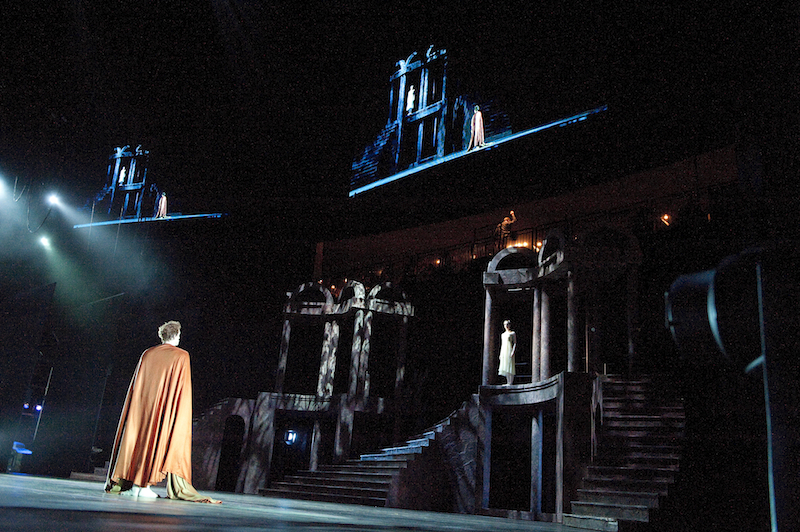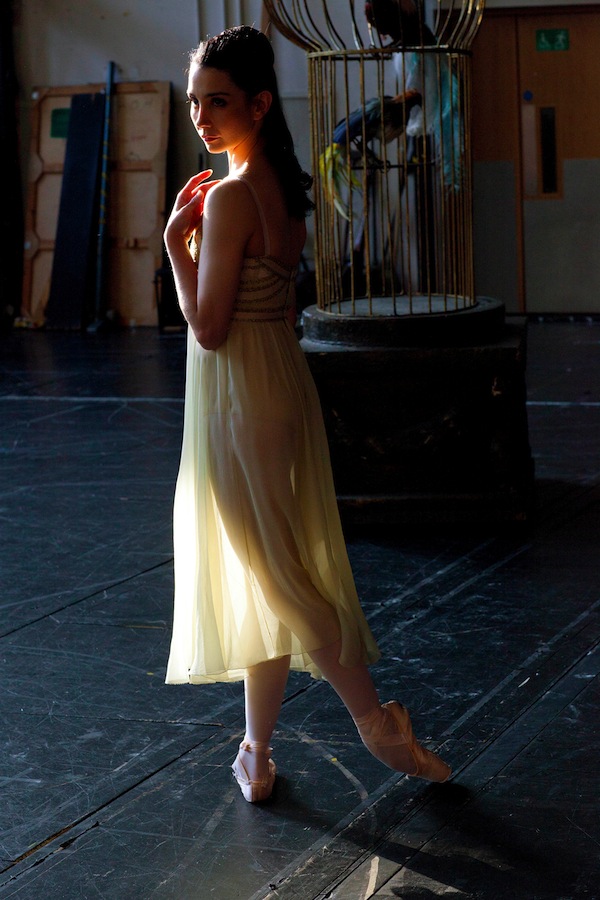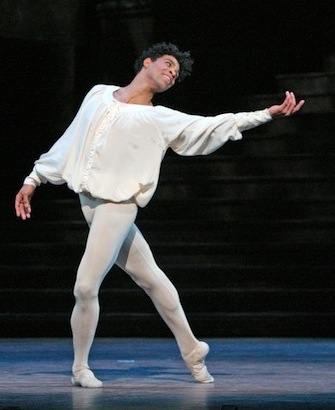Romeo and Juliet, Royal Ballet, O2 Arena | reviews, news & interviews
Romeo and Juliet, Royal Ballet, O2 Arena
Romeo and Juliet, Royal Ballet, O2 Arena
Superb performing, a clever staging, but audience behaviour is dismaying
The Royal Ballet says it is inviting a new audience to experience the thrill of live ballet by taking Romeo and Juliet to the gigantic O2. Beware what you wish for. It’s the thrill of the live audience I’m starting with before I get onto the splendid show. Sweet packets rustled behind my ear, fish and chips were wolfed nearby, pizza shared, drinks slurped. People were still entering in droves 30 minutes after the start, obstructing the view of Juliet’s first scene. People were late back for Act II, triumphantly bringing the beers and crisps in, better late than never.
Almost as bad as all of that face-feeding, the obtrusive leafing through the extra-large programme books by perplexed (or bored) spectators during the Balcony Scene, or the bedroom duet, or other of the critical highpoints. My neighbours, both young women, apparently didn’t know the story of R&J at all, and again and again I wondered how to steer them to look at the choice bits of romantic dance-drama they were missing, rather than flipping page after page back and forth in the gloom and giving me and presumably others whose view was being distracted silent conniptions.
So be prepared for live thrills of many kinds if you go to see what is in fact a classy and imaginative treatment of MacMillan’s ballet for such a vast place. Despite playing to some 12,000 seats at a time (not all filled), the ballet hasn’t had the Botoxing that might have been feared last April when a Royal Opera House blog was predicting that it would be staged on a thrust stage half the arena area. Dame Monica Mason, the Royal Ballet's director, retained the nerve instead to dance it as it is, using the wider expanse of the unwinged stage to give a greater dynamism to the floorplan - the dancers move faster and more crisply across the floor than in recent Covent Garden performances. (The one departure was an unscheduled response to a late injury, with Benvolio unexpectedly leading the Mandolin dance - an improvement which should be retained permanently.)
The scenery is minimal, just a parade of arches and stairs from Nicholas Georgiadis’s later touring redesign for the ballet, which needs the, for once, highly charged and chiaroscuro lighting of John B Read, normally the king of crepuscule.

What is obviously arena-orientated is the three large overhead screens, on which floor-level cameras project the live action, to help those in the £10 seats the length of two football pitches away see something other than specks in the distance (the Balcony Scene above, pictured by Tristram Kenton). On them too are the staging’s most innovative feature, the dramatised backstage links between scenes pre-filmed by the Ballet Boyz, former Royal Ballet dancers Michael Nunn and William Trevitt, which atmospherically set up each scene: the Capulets mustering for their celebrated Dance of the Knights, Juliet putting on her nightie before the balcony scene. These are very evocative and beautiful, with the backstage theatre lights as much part of the context as the props and costumes.
The Royal Philharmonic Orchestra and conductor Barry Wordsworth are suspended high behind in a boxed upper stage, with a sound system that from my side seat delivered the playing of the Prokofiev, warts and all (inferior brass-playing to that which you get at the ROH), with less of the left-right splitting that you get in so much theatre amplification.

 And finally to the mighty performances at the heart of last night’s show. Tamara Rojo and team are just one of four casts (this one dances again on Sunday afternoon), and Rojo, despite her small size, is a great actress of infinite craft, for whom vast spaces hold no fear. Her Juliet was a burning, aroused kid, with an unquenchable flame of desire and sense of destiny with Romeo. On stage she used her luscious arms and supple back to underscore the force of nature that is the teenage sex instinct, and on the screen her exceptional beauty of neck and eyes, her richly naturalistic acting, embodied the ultimate tragically thwarted need. (Rojo pictured right by Charlotte MacMillan.)
And finally to the mighty performances at the heart of last night’s show. Tamara Rojo and team are just one of four casts (this one dances again on Sunday afternoon), and Rojo, despite her small size, is a great actress of infinite craft, for whom vast spaces hold no fear. Her Juliet was a burning, aroused kid, with an unquenchable flame of desire and sense of destiny with Romeo. On stage she used her luscious arms and supple back to underscore the force of nature that is the teenage sex instinct, and on the screen her exceptional beauty of neck and eyes, her richly naturalistic acting, embodied the ultimate tragically thwarted need. (Rojo pictured right by Charlotte MacMillan.)
Carlos Acosta as Romeo (pictured left by Dee Conway) has a way of complementing Rojo's volcano with a laid-back male courtesy, very appealing. Though he's declared himself in his dancing twilight, he belied that idea with virile and energetic jumps, looking powerful on stage and slender on the screen. A pack of male pulchritude was nipping at his heels: Thiago Soares’s brilliantly louring, goateed Tybalt; the handsome, nimble Sergei Polunin as Benvolio; sexy, sharp José Martin as Mercutio, and Rupert Pennefather as a notably lyrical Paris. This extra sense of space at O2 favours the male dancing in this ballet, liberates their masculine energy.
Yes, there’s much to enjoy in this staging, and much could inspire people to fall under ballet’s spell, but the O2's who-cares audience policies lead to dismayingly antisocial behaviour apparently caring little for the "thrill of the live experience" for themselves or for anyone else near them. Would it be so difficult to add a large pause after the opening scene to seat latecomers, and to say drinks but no food in the arena? Would the Royal Ballet be considered "elitist" to protest? Aye, there's the rub.
- The Royal Ballet's Romeo and Juliet is at the O2 Arena, east London, this afternoon, this evening and tomorrow afternoon
- See what's on at the Royal Ballet this summer. See what's on at the Royal Ballet next season. Read Royal Ballet reviews
- theartsdesk recommends... recordings of Romeo and Juliet
- Romeo and Juliet in ballet and opera: feature on theartsdesk
Watch the Royal Ballet trailer for the O2 production
Share this article
Add comment
more Dance
 All You Need Is Death review - a future folk horror classic
Irish folkies seek a cursed ancient song in Paul Duane's impressive fiction debut
All You Need Is Death review - a future folk horror classic
Irish folkies seek a cursed ancient song in Paul Duane's impressive fiction debut
 MacMillan Celebrated, Royal Ballet review - out of mothballs, three vintage works to marvel at
Less-known pieces spanning the career of a great choreographer underline his greatness
MacMillan Celebrated, Royal Ballet review - out of mothballs, three vintage works to marvel at
Less-known pieces spanning the career of a great choreographer underline his greatness
 Carmen, English National Ballet review - lots of energy, even violence, but nothing new to say
Johan Inger's take on Carmen tries but fails to make a point about male violence
Carmen, English National Ballet review - lots of energy, even violence, but nothing new to say
Johan Inger's take on Carmen tries but fails to make a point about male violence
 WAKE, National Stadium, Dublin review - a rainbow river of dance, song, and so much else
THISISPOPBABY serves up a joyous tapestry of Ireland contemporary and traditional
WAKE, National Stadium, Dublin review - a rainbow river of dance, song, and so much else
THISISPOPBABY serves up a joyous tapestry of Ireland contemporary and traditional
 Swan Lake, Royal Ballet review - grand, eloquent, superb
Liam Scarlett's fine refashioning returns for a third season, and looks better than ever
Swan Lake, Royal Ballet review - grand, eloquent, superb
Liam Scarlett's fine refashioning returns for a third season, and looks better than ever
 First Person: Ten Years On - Flamenco guitarist Paco Peña pays tribute to his friend, the late, great Paco de Lucía
On the 10th anniversary of his death, memories of the prodigious musician who broadened the reach of flamenco into jazz and beyond
First Person: Ten Years On - Flamenco guitarist Paco Peña pays tribute to his friend, the late, great Paco de Lucía
On the 10th anniversary of his death, memories of the prodigious musician who broadened the reach of flamenco into jazz and beyond
 Dance for Ukraine Gala, London Palladium review - a second rich helping of international dancers
Ivan Putrov's latest gala was a satisfying mix of stars and young hopefuls
Dance for Ukraine Gala, London Palladium review - a second rich helping of international dancers
Ivan Putrov's latest gala was a satisfying mix of stars and young hopefuls
 Nelken: A Piece by Pina Bausch, Sadler's Wells review - welcome return for an indelible classic
A new generation of gifted performers for us to get to know
Nelken: A Piece by Pina Bausch, Sadler's Wells review - welcome return for an indelible classic
A new generation of gifted performers for us to get to know
 Dark With Excessive Bright, Royal Ballet review - a close encounter with dancers stripped bare
The Royal's Festival of New Choreography launches with an unforgettable walk in the dark
Dark With Excessive Bright, Royal Ballet review - a close encounter with dancers stripped bare
The Royal's Festival of New Choreography launches with an unforgettable walk in the dark
 La Strada, Sadler's Wells review - a long and bumpy road
Even the exceptional talents of Alina Cojocaru can't save dance adaptation of Fellini film
La Strada, Sadler's Wells review - a long and bumpy road
Even the exceptional talents of Alina Cojocaru can't save dance adaptation of Fellini film
 First Person: pioneering juggler Sean Gandini reflects on how the spirit of Pina Bausch has infiltrated his work
As Tanztheater Wuppertal Pina Bausch's 'Nelken' comes to Sadler’s Wells, a tribute from across the art forms
First Person: pioneering juggler Sean Gandini reflects on how the spirit of Pina Bausch has infiltrated his work
As Tanztheater Wuppertal Pina Bausch's 'Nelken' comes to Sadler’s Wells, a tribute from across the art forms
 Manon, Royal Ballet review - a glorious half-century revival of a modern classic
Fifty years on, Kenneth MacMillan's crash-and-burn anti-heroine is riding high
Manon, Royal Ballet review - a glorious half-century revival of a modern classic
Fifty years on, Kenneth MacMillan's crash-and-burn anti-heroine is riding high

Comments
...
...
...
...